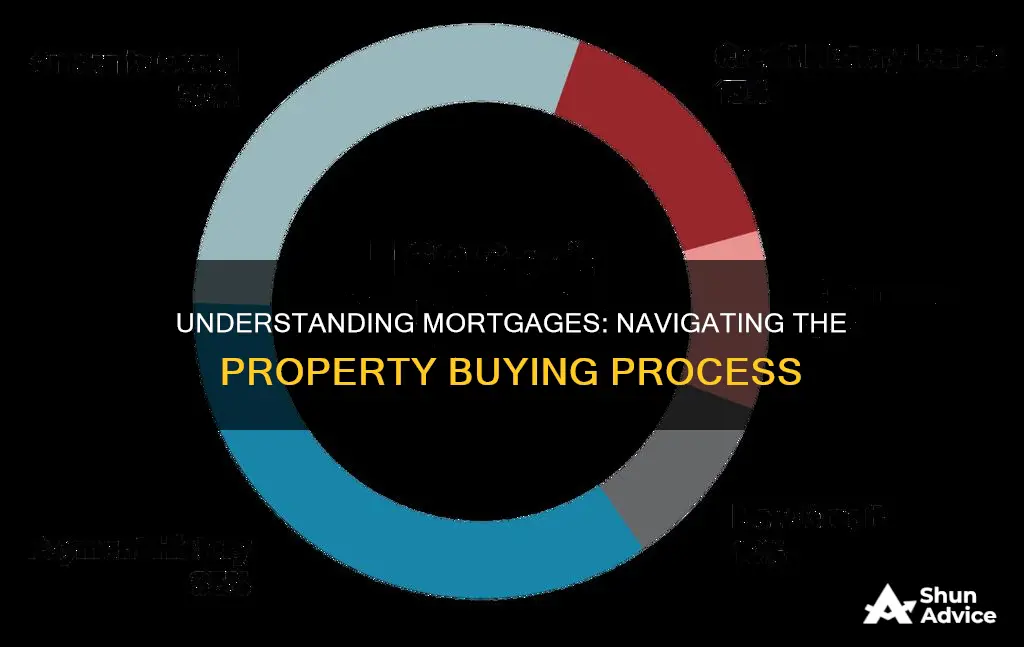
Figuring out a mortgage can be a daunting task, but it's an essential step towards owning a home. Your monthly mortgage payment is determined by various factors, including the purchase price, down payment, interest rate, loan term, property taxes, and insurance. Online mortgage calculators can provide estimates of your monthly payments, taking into account different loan types, interest rates, and additional costs such as private mortgage insurance (PMI) and homeowners association (HOA) fees. These tools help prospective homeowners understand their budget and make informed decisions about their dream home.
| Characteristics | Values |
|---|---|
| Monthly Mortgage Payment | Depends on purchase price, down payment, interest rate, loan term, property taxes and insurance. |
| Down Payment | The amount of money paid upfront when buying a home. |
| Loan Term | The length of the loan, usually 30 years but can be 20, 15 or 10 years. |
| Interest Rate | The annual percentage charged by the lender for borrowing the principal or loan amount. |
| Closing Costs | One-time fees associated with getting a mortgage, including lender's origination fee, recording fees and fees for settlement and title services. |
| Mortgage Insurance | Required if the down payment is less than 20% of the home's purchase price. |
| Homeowner's Insurance | Protection for losses and damages to the property. |
| Property Taxes | Annual taxes levied by the city, county or municipality. |
| HOA Fees | Dues paid to a homeowners association, which manages planned neighbourhoods or condo communities. |
What You'll Learn

Down payments and how they affect your mortgage
A down payment is the percentage of a home's purchase price that you pay upfront. It is money that you pay out of pocket for the home you're interested in buying. The larger the down payment, the less you'll need to borrow and pay in interest. A down payment also shows lenders that you are capable of saving money and that you are serious about your investment. It helps to build trust between you and the lender, and they may reciprocate by giving you better credit terms.
The size of your down payment can affect your mortgage interest rate. A larger down payment can lower your interest rate and, consequently, your loan-to-value ratio. This could lead to a lower interest rate offer from your lender. For example, if you make a down payment of 20% of the home's purchase price, the lender only has to lend you 80% of the purchase price. This reduces the risk for the lender. However, it's important to note that down payment requirements are not solely determined by lenders but also by the entity backing the loan, such as the Federal Housing Administration (FHA), Fannie Mae, or Freddie Mac.
The amount of your down payment can also affect the type of loan you qualify for, as some loans have minimum down payment requirements. For example, conventional loans typically require a down payment of at least 5%, but some lenders may accept a 3% down payment for certain types of loans. If you put down less than 20%, you will usually need to pay for mortgage insurance, which will increase your monthly mortgage payment. The cost of private mortgage insurance varies based on factors such as credit score, down payment amount, and loan type.
Additionally, your down payment can impact your monthly mortgage payment. A higher down payment can save you money in the long run by reducing the total amount you need to borrow. This, in turn, can lower your monthly payments. However, it's important to consider your other expenses and financial goals when deciding on the down payment amount. As Mark Hamrick, a senior economic analyst at Bankrate, advises, "Being conservative and cautious with a home purchase is advisable."
Understanding Mortgage Amortization: Strategies for Homeowners
You may want to see also

Monthly payments and how to calculate them
Your monthly mortgage payment depends on a number of factors, including the purchase price, down payment, interest rate, loan term, property taxes, and insurance. The purchase price refers to the total amount you agree to pay the property seller, which is typically different from the loan amount, as most lenders won't loan you the full amount of the property's purchase price. The down payment is the cash you pay upfront when buying a home, usually a minimum of 3% of the price of the home, although some loans allow zero down. The larger your down payment, the less you'll need to borrow and pay in interest.
The interest rate is the amount a lender charges you for borrowing money, expressed as an annual percentage. The loan term is the length of your loan, usually 30 years but can be 20, 15, or 10 years. The principal is the amount you borrowed from the lender, or the home's price minus the down payment.
There are several online mortgage calculators that can help you estimate your monthly payments. You can input variables such as the price of the home, the down payment amount, the interest rate, and the loan term to calculate your estimated monthly payment. These calculators can also help you factor in other costs, such as homeowner's insurance, property taxes, and private mortgage insurance (PMI). PMI is typically required if your down payment is less than 20% of the home's purchase price, and it can vary based on factors such as credit score, down payment, and loan type.
You can also calculate your monthly mortgage payments manually using standard formulas. One formula provided involves the loan amount, the interest rate, the loan term, and the number of payments per year.
Becoming a Licensed Mortgage Originator in Texas
You may want to see also

The 28/36 rule and how to follow it
The 28/36 rule is a standard that most lenders use to determine how much debt a consumer can safely assume based on their income, other debts, and financial needs. It is a guideline that helps lenders structure underwriting requirements. The rule calculates debt limits that an individual or household should meet to be well-positioned for credit applications. It measures income against debt.
The 28/36 rule reflects what is known as the front-end and back-end ratios on a mortgage:
- Front-end ratio (28 percent): The maximum percentage of gross monthly income you should spend on housing.
- Back-end ratio (36 percent): The maximum percentage of gross monthly income you should spend on all of your debt, including housing. This is also known as your DTI (debt-to-income) ratio.
To follow the 28/36 rule, your monthly mortgage payment should not be higher than 28% of your gross income, and your total debt payments should not exceed 36% of your income. The rule is based on gross income, so it is calculated before taxes.
The 28/36 rule is an important calculation that determines a consumer's financial status. It helps lenders ensure that you don't overextend yourself financially. It is also beneficial for individuals to understand their financial standing and estimate their chances of getting a loan.
While the 28/36 rule is a common guideline, it is not a law. Many lenders allow a higher DTI ratio, and some may vary these parameters based on a borrower's credit score. For example, a high credit score may allow borrowers to have a slightly higher DTI ratio. Additionally, other factors such as personal circumstances, inflation, wages, and insurance premiums can impact housing affordability.
Obtaining Five Mortgages: A Comprehensive Guide
You may want to see also

How to calculate your debt-to-income ratio
Your debt-to-income ratio (DTI) is a critical factor in determining whether you qualify for a mortgage. Lenders use it to assess how well you manage your monthly obligations and if you can afford to take on more debt. It is calculated by dividing your total monthly debt payments by your monthly income.
The DTI ratio is expressed as a percentage, and lenders generally view consumers with higher DTIs as riskier borrowers. This is because a large proportion of their income is already committed to debt payments, and they may struggle to repay new loans, especially if their income decreases. The ideal front-end ratio (housing ratio) should be no more than 28%, and the back-end ratio (total debt ratio) should be 36% or lower. The front-end ratio includes monthly housing expenses such as mortgage payments, property taxes, homeowners insurance, and homeowners association dues. The back-end ratio includes all monthly debt obligations, such as credit card bills, car loans, and student loans, in addition to the housing expenses mentioned.
It is important to note that expenses like groceries, utilities, gas, and taxes are generally not included in the DTI calculation. Additionally, taking on new loans before or during a home purchase is not advisable, as it can increase your DTI and negatively impact your credit score.
You can use online DTI calculators provided by financial institutions like Wells Fargo and Bankrate to estimate your DTI and understand your financial health. These calculators are for educational purposes and do not guarantee credit approval. When applying for a mortgage, lenders may calculate your DTI based on verified income and debt amounts, which could differ from the estimates provided by the calculators.
Profiting from Real Estate Mortgages: A Beginner's Guide
You may want to see also

How to calculate the interest on your mortgage
Calculating the interest on your mortgage can be done in a few steps. Firstly, it is important to understand the components of a mortgage payment. The principal is the original loan amount borrowed, excluding any interest. The interest is the amount the lender charges for lending the principal. This is expressed as an annual percentage.
The formula to calculate the interest on a simple interest loan is: SI = P * R * T, where SI is the interest, P is the principal, R is the interest rate, and T is the loan term. For example, if you owe $300,000 on a mortgage with a rate of 4%, you will initially owe $1,000 in monthly interest ($300,000 x 0.04 ÷ 12). The rest of the payment will be applied to the principal.
Online loan calculators can be used to calculate more complex amortized loans, which show how the interest payments work. These calculators can also help you determine how much house you can afford and whether you are spending more than you can afford. You can input variables such as the purchase amount, down payment, interest rate, and loan term.
It is worth noting that there are ways to reduce the amount of interest paid on a mortgage. These include shopping around for a better interest rate, making more frequent payments, making extra payments, and choosing a shorter loan term.
Employment Verification: A Crucial Step in Mortgage Approval
You may want to see also
Frequently asked questions
Your monthly mortgage payment includes the principal, which is the amount you borrowed, and the interest, which is the amount the lender charges for lending you the money. It may also include homeowner's insurance, taxes, and HOA fees.
A higher down payment will save you money in the long run as it will reduce the amount you need to borrow and pay in interest. Most home loans require at least 3% of the price of the home as a down payment, but some loans like VA loans and some USDA loans don't require any down payment.
Many mortgage lenders generally expect a 20% down payment for a conventional loan with no private mortgage insurance (PMI). To calculate your DTI, add all your monthly debt payments (e.g. credit card debt, student loans, auto loans), then divide by your monthly, pre-tax income. Multiply by 100 to get a percentage.
Fixed-rate loans offer a consistent rate and monthly payment over the life of the loan, typically with 10-, 15-, 20- or 30-year loan terms. In most countries, home loans are variable or adjustable, which means the interest rate can change.
You can use a mortgage calculator to estimate your monthly mortgage payment. These calculators take into account factors such as the home price, down payment, interest rate, loan term, and other costs such as insurance and taxes.







